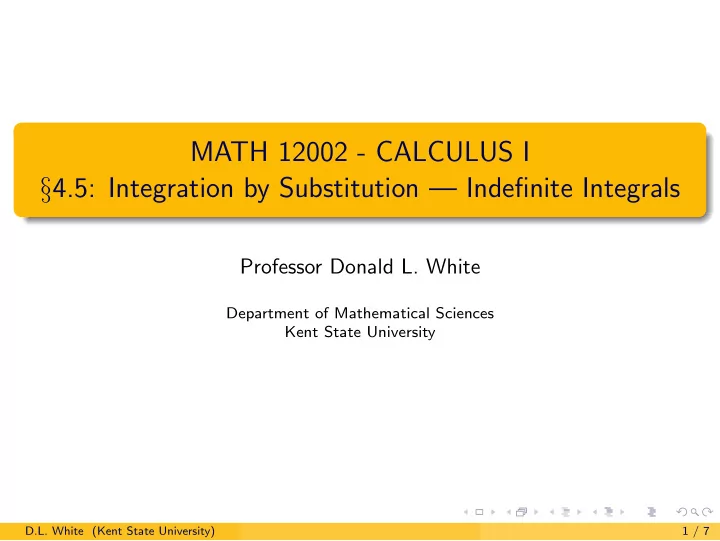

MATH 12002 - CALCULUS I § 4.5: Integration by Substitution — Indefinite Integrals Professor Donald L. White Department of Mathematical Sciences Kent State University D.L. White (Kent State University) 1 / 7
Examples � (3 x 2 + 10 x ) � x 3 + 5 x 2 dx . 1 Evaluate the integral � � � (3 x 2 + 10 x ) x 3 + 5 x 2 (3 x 2 + 10 x ) dx � x 3 + 5 x 2 dx = Let u = x 3 + 5 x 2 so du = (3 x 2 + 10 x ) dx � √ u du = � u 1 / 2 du = 3 u 3 / 2 + C 2 = 3 ( x 3 + 5 x 2 ) 3 / 2 + C . 2 = D.L. White (Kent State University) 2 / 7
Examples x 4 � 2 Evaluate the integral ( x 5 + 7) 10 dx . x 4 � � x 4 ( x 5 + 7) − 10 dx = ( x 5 + 7) 10 dx Let u = x 5 + 7 so du = 5 x 4 dx 5 du = x 4 dx and 1 � u − 10 · 1 = 5 du � u − 10 du 1 = 5 − 9 u − 9 + C 1 1 = 5 · 45 ( x 5 + 7) − 9 + C . − 1 = D.L. White (Kent State University) 3 / 7
Examples � sin √ x 3 Evaluate the integral √ x dx . � sin √ x (sin √ x ) 1 � √ x = √ x dx dx Let u = √ x = x 1 / 2 2 x − 1 / 2 dx = 1 so du = 1 1 2 · √ x dx 1 and 2 du = √ x dx � = (sin u ) · 2 du � = 2 sin u du = 2( − cos u ) + C − 2 cos √ x + C . = D.L. White (Kent State University) 4 / 7
Examples � cos 7 x sin x dx . 4 Evaluate the integral � � cos 7 x sin x dx (cos x ) 7 sin x dx = Let u = cos x so du = − sin x dx and ( − 1) du = sin x dx � u 7 ( − 1) du = � u 7 du = − 8 u 8 + C − 1 = 8 cos 8 x + C . − 1 = D.L. White (Kent State University) 5 / 7
Examples � x 5 Evaluate the integral √ x + 7 dx . In this case, the inside of the composite function is x + 7, but what is outside is not exactly the derivative of x + 7. A sum under a radical can complicate an integral because, for example, √ √ x + 7 � = √ x + 7 . We can handle a sum in a numerator because, for example, � x 5 + x � x 5 x 3 + x � x 2 + x − 2 dx , dx = x 3 dx = x 3 which can be evaluated easily, while a sum in a denominator is a problem: x 5 + x � = x 3 x 3 x 5 + x 3 x . [Continued → ] D.L. White (Kent State University) 6 / 7
Examples � [Example 5, √ x +7 dx , continued] x Both of these issues can be avoided by letting u = x + 7, so that du = dx . In the integral, √ x + 7 becomes √ u and dx becomes du . Since u = x + 7, we can write x in terms of u as x = u − 7. We have � u − 7 � x √ x + 7 dx = √ u du � √ u − 7 u = √ u du � u 7 = u 1 / 2 − u 1 / 2 du � u 1 / 2 − 7 u − 1 / 2 du = 3 u 3 / 2 − 7 · 2 u 1 / 2 + C 2 = 3 ( x + 7) 3 / 2 − 14( x + 7) 1 / 2 + C . 2 = D.L. White (Kent State University) 7 / 7
Recommend
More recommend